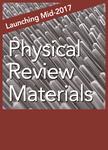版权所有:内蒙古大学图书馆 技术提供:维普资讯• 智图
内蒙古自治区呼和浩特市赛罕区大学西街235号 邮编: 010021

作者机构:Materials Theory ETH Zürich Wolfgang-Pauli-Strasse 27 8093 Zürich Switzerland
出 版 物:《Physical Review Materials》 (Physic. Rev. Mat.)
年 卷 期:2018年第2卷第10期
页 面:104409-104409页
核心收录:
基 金:German Science Foundation Schweizerischer Nationalfonds zur Förderung der Wissenschaftlichen Forschung, SNF, (200021E-162297)
主 题:Exchange interaction Ferroelectricity Magnetism Magnetoelectric effect Ferroelectrics Magnetic systems Multiferroics Perovskites Density functional calculations Metropolis algorithm Molecular dynamics
摘 要:Perovskite structure SrMnO3 is a rare example of a multiferroic material where strain tuning and/or cation substitution could lead to coinciding magnetic and ferroelectric ordering temperatures, which would then promise strong magnetoelectric coupling effects. Here, we establish the temperature- and strain-dependent ferroic phase diagram of SrMnO3 using first-principles-based effective Hamiltonians. All parameters of these Hamiltonians are calculated using density functional theory, i.e., no fitting to experimental data is required. Temperature-dependent properties are then obtained from Monte Carlo and molecular dynamics simulations. We observe a sequence of several magnetic transitions under increasing tensile strain, with a moderate variation of the corresponding critical temperatures. In contrast, the ferroelectric Curie temperature increases strongly after its onset around 2.5% strain, and indeed crosses the magnetic transition temperature just above 3% strain. Our results indicate pronounced magnetoelectric coupling, manifested in dramatic changes of the magnetic ordering temperatures and different magnetic ground states as function of the ferroelectric distortion. In addition, coexisting ferroelectric and ferromagnetic order is obtained for strains above 4%. Our calculated phase diagram suggests the possibility to control the magnetic properties of SrMnO3 through an applied electric field, significantly altering the magnetic transition temperatures, or even inducing transitions between different magnetic states.